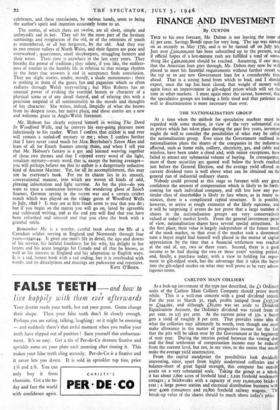FINANCE AND INVESTMENT
By CUSTOS
Thug to his own forecast, Mr. Dalton is not leaving the issue of 23- per cent. Savings Bonds open for very long. The tap was turned on as recently as May 17th, and is to -be turned off on July 9th. Just over £300,000,00o has been subscribed up to the present, and if official hopes of a last-minute rush are fulfilled a total of some- thing like £400,000,000 should be reached. Assuming, if one may, that the American loan goes through, Mr. Dalton may now be well placed to meet his finaiiifial requirements without further resort to the tap or to any new Government loan for a considerable time ahead. That is a strong hand from which to lead, and I should expect, once the tap has. been closed, that weight of money will again force an improvement in gilt-edged prices which will set the tone in other markets. I must again enter the caveat, however, that the speculative groups are looking a little tired and that patience as well as discrimination is more necessary than ever.
THE NATIONALISATION GROUP At a time when the outlook for speculative markets must be regarded with some cfaution, in view of the very substantial rise in prices which has taken place during the past five years, investors- might do well to consider the possibilities of what may be called the nationalisation group. Ever since the Government outlined its. nationalisation plans the shares of the companies- in the industries affected, such as home rails, colliery, electricity, gas, and cable 'and wireless, have been under a cloud and, with minor exceptions, have failed to attract any substantial volume of buying. In consequence, most of these securities are quoted well below the levels .reached just before the General Election, and the average yield offered on current dividend rates is well above what can be obtained on the general run of industrial ordinary shares.
Nobody could pretend at this stage to foreeast with any great confidence the amount of compenSation which is likely to be forth- coming for each individual company, and still less how any par- ticular class of sharehOlder is likely to fare where, as in fnany in- stances, there is a complicated capital structure. It is possible, however, to arrive at rough estimates of the likely outcome, and it will be surprising if events do not prove that a large number of shares in the nationalisation groups are very conservatively valued at today's market levels. From the general investment point of view, nationalisation shares have several special attractions. In the first place, their value is largely independent of the future trend of the stock market, so that even if the market took a downward turn a buyer might find himself well placed in the matter of capital appreciation by the time that a financial settlement was reached at the end of, say, two or three years. Second, there is a good income to be had during the two or three years' waiting period ; and, finally, a purchase today, with a view to holding for repay- ment in gilt-edged stock, has the advantage that it takes the buyer into the gilt-edged market on what may well prove to be very advan- tageous terms.
CARLTON MAIN COLLIERY
As a lock-up investment of the type just described, the £i Ordinary units of the Carlton Main Colliery Company should prove worth while. This is a well-run concern with a good dividend record. For the year to Mardh 31, 1946, profits jumped from £137,32o to ,C244,091, and although '£85,000 was set aside to Dividend Equalisation Account, the Ordinary dividend was raised from to per cent. to 123- per cent. At the current price of 33s. a buyer _gets a yield of roughly .8 per cent. That provides some idea of what the collieries may ultimately , be worth, even though one mus make allowance in the matter of prospective income for the fact that the pits will be taken over by the Government at the beginning of next year. During the interim period between the vesting' date and the final settlement of compensation income may be reduced from the current level, but not, in my view, to the extent that would make the average yield unattractive.
From the. capital standpoint the possibilities look •decidedly interesting, since, apart from highly modernised collieries and a balance-sheet of great liquid strength, this company has outside assets on a very substantial scale. Taking the group as a whole, it has about 2,600 acres of freehold land ; -2,100 freehold workmen's cottages ; a brickworks with a capacity of over to,000,000 brick c a year ; a large power station and electrical distribution business with over 4,000 consumers and to,800 freehold railway wagons. The break-up value of the shares should be much above today's price


























 Previous page
Previous page